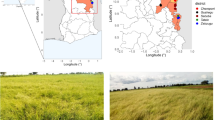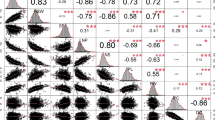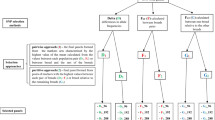Abstract
Comprehensive identification of the breed characteristics is essential for the effective management of farm animal genetic resources. The objective of this study was to estimate effective population size, genomic inbreeding coefficients, autozygosity derived from runs of homozygosity, and genetic diversity in Iranian native cattle using dense SNP markers. Ten samples per breed were collected from eight Iranian native cattle breeds representing the Sarabi, Kurdi, Najdi, Taleshi, Mazandarani, Pars, Kermani, and Sistani breeds. Samples were genotyped for 777,962 SNPs using the Illumina BovineHD BeadChip, and after quality control 450,341 SNPs were kept for further analyses. The estimated effective population size (Ne) was relatively small for all breeds, varying from Ne = 13 (Sarabi) to Ne = 107 (Mazandarani). Analysis of runs of homozygosity in different cut-off lengths was applied to provide information on the recent and ancient inbreeding occurrences in each population. The inbreeding coefficients estimated by runs of homozygosity varied between breeds. Sarabi, Pars, and Sistani breeds had higher proportion of long runs of homozygosity, likely to reflect recent inbreeding, while Kermani breed had the higher number of short runs of homozygosity. Some breeds such as Sarabi, Sistani, Pars, Taleshi, and Kermani are exposed to serious risk of extinction and other breeds, except Mazandarani, have no promising situations. Higher priority should be given to conservation programming in Sarabi and Sistani breeds due to unique genetic composition and critical conservation status.






Similar content being viewed by others
References
Biscarini F, Biffani S, Morandi N, Nicolazzi EL, Stella A (2014) Using runs of homozygosity to detect genomic regions associated with susceptibility to infectious and metabolic diseases in dairy cows under intensive farming conditions. ELARES:56
Bjelland DW, Weigel KA, Vukasinovic N, Nkrumah JD (2013) Evaluation of inbreeding depression in Holstein cattle using whole-genome SNP markers and alternative measures of genomic inbreeding. J Dairy Sci 96:4697–4706. doi:10.3168/jds.2012-6435
Charlesworth D, Willis JH (2009) The genetics of inbreeding depression. Nat Rev Genet 10:783–796. doi:10.1038/nrg2664
Curik I, Ferenčaković M, Karapandza N, Cubric Curik V, Sölkner J (2014) Estimation of inbreeding and effective population size in Istrian cattle using molecular information. Acta Agrar Kaposváriensis 18(1):30–34
Decker JE, Pires JC, Conant GC et al (2009) Resolving the evolution of extant and extinct ruminants with high-throughput phylogenomics. PNAS 106:18644–18649. doi:10.1073/pnas.0904691106
Do C, Waples RS, Peel D, Macbeth GM, Tillett BJ, Ovenden JR (2014) NEESTIMATOR v2: re-implementation of software for the estimation of contemporary effective population size (Ne) from genetic data. Mol Ecol Resour 14(1):209–214. doi:10.1111/1755-0998.12157
Edea Z, Dadi H, Kim S, Dessie T, Lee T, Kim H, Kim J, Kim K (2013) Genetic diversity, population structure and relationships in indigenous cattle populations of Ethiopia and Korean Hanwoo breeds using SNP markers. Front Genet 4:35. doi:10.3389/fgene.2013.00035
Engelsma KA, Veerkamp RF, Calus MPL, Bijma P, Windig JJ (2012) Pedigree and marker based methods in the estimation of genetic diversity in small groups of Holstein cattle. J Anim Breed Genet 129:195–205. doi:10.1111/j.1439-0388.2012.00987.x
Engelsma KA, Veerkamp RF, Calus MPL, Windig JJ (2014) Consequences for diversity when animals are prioritized for conservation of the whole genome or of one specific allele. J Anim Breed Genet 131(1):61–70. doi:10.1111/jbg.12052
Evanno G, Regnaut S, Goudet J (2005) Detecting the number of clusters of individuals using the software STRUCTURE: a simulation study. Mol Ecol 14:2611–2620
FAO (2007) The state of the world’s animal genetic resources for food and agriculture. In: Rischkowsky B, Pilling D (eds) United Nations Food and Agriculture Organization (FAO), Rome, Italy
Ferencakovic M, Hamzic E, Gredler B, Solberg TR, Klemetsdal G, Curik I, Solkner J (2013a) Estimates of autozygosity derived from runs of homozygosity: empirical evidence from selected cattle populations. J Anim Breed Genet 130:286–293. doi:10.1111/jbg.12012
Ferencakovic M, Solkner J, Curik I (2013b) Estimating autozygosity from high-throughput information: effects of SNP density and genotyping errors. Genet Sel Evol 45(1):42. doi:10.2527/jas2014-7898
Flury C, Tapio M, Sonstegard T, Drogemuller C, Leeb T, Simianer H, Hanotte O, Rieder S (2010) Effective population size of an indigenous Swiss cattle breed estimated from linkage disequilibrium. J Anim Breed Genet 127:339–347. doi:10.1111/j.1439-0388.2010.00862.x
Frankham R (2005) Genetics and extinction. Biol Conserv 126:131–140. doi:10.1016/j.biocon.2005.05.002
Frankham R, Bradshaw CJA, Brook BW (2014) Genetics in conservation and management: revised recommendations for the 50/500 rules, Red List criteria and population viability analyses. Biol Conserv 170:56–63
Franklin IR (1980) Evolutionary change in small populations. In: Soulé ME, Wilcox BA (eds) Conservation biology: an evolutionary-ecological perspective. Sinauer Associates, Sunderland, pp 135–150
Garcia-Gámez E, Sahana G, Gutiérrez-Gil B, Arranz JJ (2012) Linkage disequilibrium and inbreeding estimation in Spanish Churra sheep. BMC Genet 13:43. doi:10.1186/1471-2156-13-43
Gasca-Pineda J, Cassaigne I, Alonso RA, Eguiarte LE (2013) Effective population size, genetic variation, and their relevance for conservation: the Bighorn sheep in Tiburon island and comparisons with managed Artiodactyls. PLoS One 8(10):e78120. doi:10.1371/journal.pone.0078120
Gautier M, Laloe D, Moazami-Goudarzi K (2010) Insights into the genetic history of French cattle from dense SNP data on 47 worldwide breeds. PLoS One 5(9):e13038. doi:10.1371/journal.pone.0013038
Gibson J, Morton NE, Collins A (2006) Extended tracts of homozygosity in outbred human populations. Hum Mol Genet 15:789–795
Gorbach DM, Makgahlela ML, Reecy JM, Kemp SJ et al (2010) Use of SNP genotyping to determine pedigree and breed composition of dairy cattle in Kenya. J Anim Breed Genet 127:348–351. doi:10.1111/j.1439-0388.2010.00864.x
Groeneveld LF, Lenstra JA, Eding H, Toro MA, Scherf B et al (2010) Genetic diversity in farm animals–a review. Anim Genet 41:6–31. doi:10.1111/j.1365-2052.2010.02038.x
Harmon LJ, Stanton B (2010) Conservation of small populations: Effective population sizes, inbreeding, and the 50/500 rule. In: Braude S, Low BS (eds) An introduction to methods and models in ecology, evolution, and conservation biology. Princeton University Press, Princeton, pp 125–138
Hill WG (1981) Estimation of effective population size from data on linkage disequilibrium. Genet Res 38:209–216
Hoffmann I (2010) Climate change and the characterization, breeding and conservation of animal genetic resources. Anim Genet 41:32–46. doi:10.1111/j.1365-2052.2010.02043.x
Kim ES, Cole JB, Huson H, Wiggans GR, Van Tassell CP, Crooker BA, Liu G, Da Y, Sonstegard TS (2013) Effect of artificial selection on runs of homozygosity in U.S. Holstein cattle. PLoS One 8(11):e80813. doi:10.1371/journal.pone.0080813
Kirin M, McQuillan R, Franklin CS, Campbell H, McKeigue PM, Wilson JF (2010) Genomic runs of homozygosity record population history and consanguinity. PLoS One 5(11):e13996. doi:10.1371/journal.pone.0013996.g001
Lee SH, Cho YM, Lim D, Kim HC, Choi BH, Park HS, Kim OH, Kim S, Kim TH, Yoon D, Hong SK (2011) Linkage disequilibrium and effective population size in Hanwoo Korean cattle. Asian Australas J Anim Sci 24:1660–1665. doi:10.5713/ajas.2011.11165
Luikart G, Ryman N, Tallmon DA, Schwartz MK, Allendorf FW (2010) Estimation of census and effective population sizes: the increasing usefulness of DNA-based approaches. Conserv Genet 11:355–373. doi:10.1007/s10592-010-0050-7
Makina SO, Muchadeyi FC, van Marle-Koster E, MacNeil MD, Maiwashe A (2014) Genetic diversity and population structure among six cattle breeds in South Africa using a whole genome SNP panel. Front Genet 5:333. doi:10.3389/fgene.2014.00333
Markert JA, Champlin DM, Gutjahr-Gobell R, Grear JS, Kuhn A, McGreevy TJ, Roth A, Bagley MJ, Nacci DE (2010) Population genetic diversity and fitness in multiple environments. BMC Evol Biol 10:205. doi:10.1186/1471-2148-10-205
Marras G, Gaspa G, Sorbolini S, Dimauro C, Ajmone-Marsan P, Valentini A, Williams JL, Macciotta NP (2015) Analysis of runs of homozygosity and their relationship with inbreeding in five cattle breeds farmed in Italy. Anim Genet 46:110–121. doi:10.1111/age.12259 (Epub 2014 Dec 22)
Mastrangelo S, Saura M, Tolone M, Salces-Ortiz J, Di Gerlando R, Bertolini F, Fontanesi L, Sardina MT, Serrano M, Portolano B (2014) The genome-wide structure of two economically important indigenous Sicilian cattle breeds. J Anim Sci 92(11):4833–4842. doi:10.2527/jas.2014-7898
Mc Parland S, Kearney JF, Rath M, Berry DP (2007) Inbreeding effects on milk production, calving performance, fertility, and conformation in Irish Holstein-Friesians. J Dairy Sci 90:4411–4419. doi:10.3168/jds.2007-0227
McQuillan R, Leutenegger AL, Abdel-Rahman R, Franklin CS, Pericic M, Barac-Lauc L, Smolej-Narancic N, Janicijevic B, Polasek O, Tenesa A, Macleod AK, Farrington SM, Rudan P, Hayward C, Vitart V, Rudan I, Wild SH, Dunlop MG, Wright AF, Campbell H, Wilson JF (2008) Runs of homozygosity in European populations. Am J Hum Genet 83:359–372
Medugorac I, Veit-Kensch CE, Ramljak J, Brka M, Marković B, Stojanović S et al (2011) Conservation priorities of genetic diversity in domesticated metapopulations: a study in taurine cattle breeds. Ecol Evol 1(3):408–420. doi:10.1002/ece3.39
Nei M (1972) Genetic distance between populations. Am Nat 106:283–292
Paradis E, Claude J, Strimmer K (2004) APE: analyses of phylogenetics and evolution in R language. Bioinformatics 20(2):289–290. doi:10.1093/bioinformatics/btg412
Pemberton TJ, Absher D, Feldman MW, Myers RM, Rosenberg NA, Li JZ (2012) Genomic patterns of homozygosity in worldwide human populations. Am J Hum Genet 91(2):275–292
Pertoldi C, Purfield DC, Berg P, Jensen TH, Bach OS, Vingborg R, Kristensen TN (2014) Genetic characterization of a herd of the endangered Danish Jutland cattle. J Anim Sci 92:2372–2376. doi:10.2527/jas.2013-7206
Pritchard JK, Stephens M, Donnelly P (2000) Inference of population structure using multi locus genotype data. Genetics 155:945–959
Pruett CL, Winker K (2008) The effects of sample size on population genetic diversity estimates in song sparrows Melospiza melodia. J Avian Biol 39:252–256
Purcell S, Neale B, Todd-Brown K, Thomas L, Ferreira MA, Bender D, Maller J, Sklar P, de Bakker PI, Daly MJ, Sham PC (2007) PLINK: a tool set for whole-genome association and population-based linkage analyses. Am J Hum Genet 81:559–575. doi:10.1086/519795
Purfield D, Berry D, McParland S, Bradley D (2012) Runs of homozygosity and population history in cattle. BMC Genet 13:70. doi:10.1186/1471-2156-13-70
Scraggs E, Zanella R, Wojtowicz A, Taylor JF, Gaskins CT, Reeves JJ, de Avila JM, Neibergs HL (2014) Estimation of inbreeding and effective population size of full-blood Wagyu cattle registered with the American Wagyu cattle association. J Anim Breed Genet 131:3–10. doi:10.1111/jbg.12066
Smith O, Wang J (2014) When can noninvasive samples provide sufficient information in conservation genetics studies? Mol Ecol Resour 14:1011–1023
Taberlet P, Valentini A, Rezaei HR, Naderi S, Pompanon F, Negrini R, Ajmone-Marsan P (2008) Are cattle, sheep, and goats endangered species? Mol Ecol 17:275–284
Talle SB, Chenyabuga WS, Fimland E, Syrstad O, Meuwissen T, Klungland H (2005) Use of DNA technologies for the conservation of animal genetic resources: a review. Acta Agric Scand Sect A Anim Sci 55:1–8. doi:10.1080/09064700510009315
Theodorou K, Couvet D (2006) On the expected relationship between inbreeding, fitness, and extinction. Genet Sel Evol 38(4):371–387. doi:10.1051/gse:2006010
Tiwari R, Dileep Kumar H, Dutt T, Singh BP, Pachaiyappan K, Dhama K (2014) Future challenges of food security and sustainable livestock production in India in the changing climatic scenario. Asian J Anim Vet Adv 9:367–384. doi:10.3923/ajava.2014.367.384
Uzzaman MR, Edea Z, Bhuiyan MSA, Walker J, Bhuiyan AKFH, Kim KS (2014) Genome-wide single nucleotide polymorphism analyses reveal genetic diversity and structure of wild and domestic cattle in Bangladesh. Asian Australas J Anim Sci 27(10):1381–1386. doi:10.5713/ajas.2014.14160
Waples RS (2006) A bias correction for estimates of effective population size based on linkage disequilibrium at unlinked gene loci. Conserv Genet 7(2):167–184. doi:10.1007/s10592-005-9100-y
Willing E, Dreyer C, van Oosterhout C (2012) Estimates of genetic differentiation measured by F ST do not necessarily require large sample sizes when using many snp markers. PLoS One 7(8):e42649. doi:10.1371/journal.pone.0042649
Yang J, Lee SH, Goddard ME, Visscher PM (2011) GCTA: a tool for Genome-wide complex trait analysis. Am J Hum Genet 88(1):76–82. doi:10.1016/j.ajhg.2010.11.011 (Epub 2010 Dec 17)
Zheng X, Levine D, Shen J, Gogarten SM, Laurie C, Weir BS (2012) A high-performance computing toolset for relatedness and principal component analysis of SNP data. Bioinformatics 28:3326–3328
Acknowledgments
The authors would like to thank the participant farmers for their collaboration in collecting samples from their animals, and the officials of the cattle breeding stations in Iran for facilitating the sampling process. This work was supported by a grant from the Next Generation BioGreen 21 Program (No. PJ008196), Rural Development Administration, Republic of Korea.
Author information
Authors and Affiliations
Corresponding author
Rights and permissions
About this article
Cite this article
Karimi, K., Esmailizadeh Koshkoiyeh, A., Asadi Fozi, M. et al. Prioritization for conservation of Iranian native cattle breeds based on genome-wide SNP data. Conserv Genet 17, 77–89 (2016). https://doi.org/10.1007/s10592-015-0762-9
Received:
Accepted:
Published:
Issue Date:
DOI: https://doi.org/10.1007/s10592-015-0762-9




